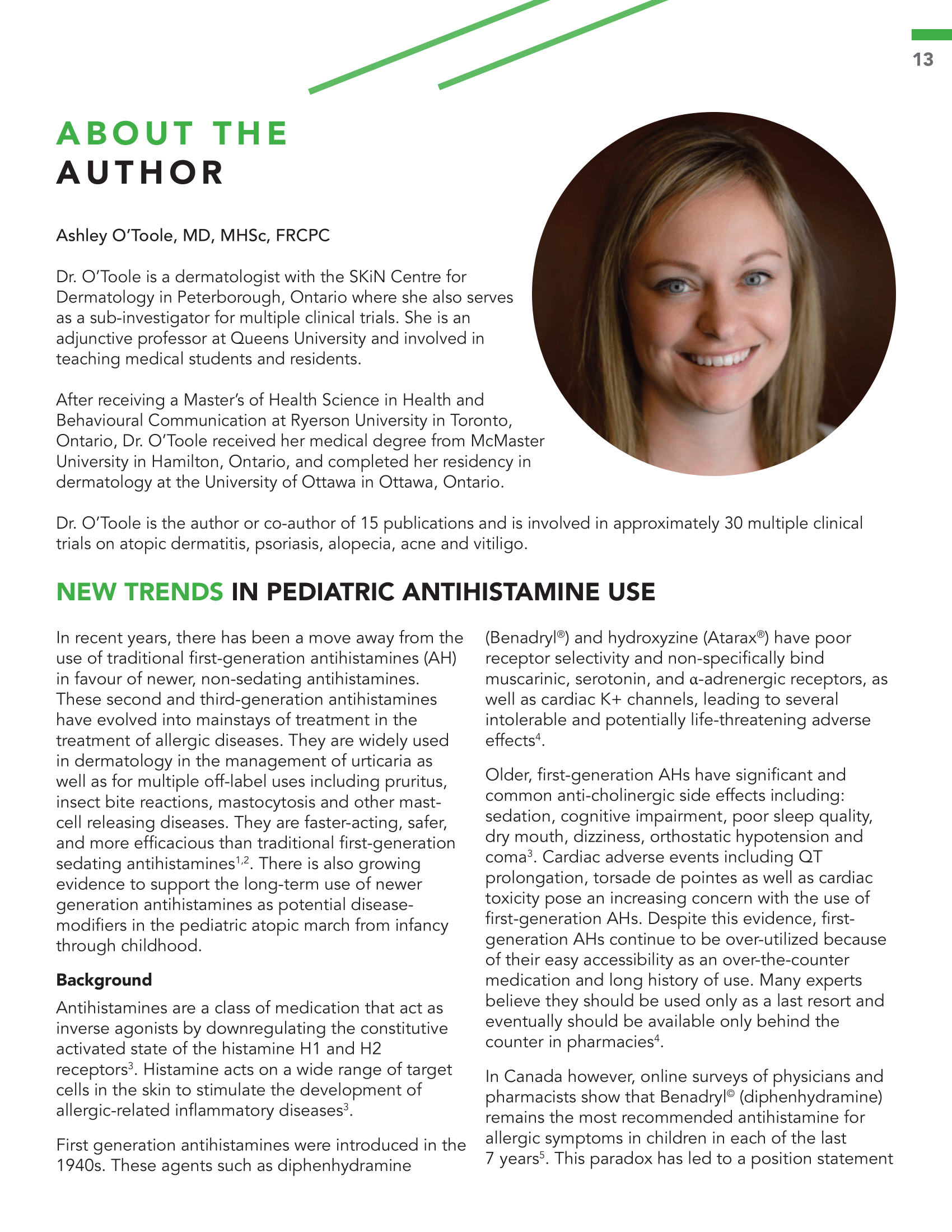New trends in pediatric antihistamine use
Abstract
In recent years, there has been a move away from the use of traditional first-generation antihistamines (AH) in favour of newer, non-sedating antihistamines. These second and third-generation antihistamines have evolved into mainstays of treatment in the treatment of allergic diseases. They are widely used in dermatology in the management of urticaria as well as for multiple off-label uses including pruritus, insect bite reactions, mastocytosis and other mast-cell releasing diseases. They are faster-acting, safer, and more efficacious than traditional first-generation sedating antihistamines. There is also growing evidence to support the long-term use of newer generation antihistamines as potential disease-modifiers in the pediatric atopic march from infancy through childhood.
References
Simons FE, Simons KJ, et al. Histamine and H1 antihistamines. In: Adkinson JN, et al., editors. Middleton’s allergy principles and practice. Elsevier Saunders: Philadelphia; 2014. pp. 1503–1533.
Simons FE, Simons KJ. Histamine and H1-antihistamines: celebrating a century of progress. J Allergy Clin Immunol. 2011;128(6):1139–1150. doi: 10.1016/j.jaci.2011.09.005.
Isaacs MJ, Tharp MD. Antihistamines. In: Wolverton S, Wu J. Comprehensive Dermatologic Drug Therapy (Fourth Edition). Elsevier. 2021, 349-357.
Fein MN, Fischer DA, O’Keefe AW, Sussman GL. CSACI position statement: Newer generation H1-antihistamines are safer than first-generation H1-antihistamines and should be the first-line antihistamines for the treatment of allergic rhinitis and urticaria. Allergy Asthma Clin Immunol. 2019 Oct 1;15:61. doi: 10.1186/s13223-019-0375-9. PMID: 31582993; PMCID: PMC6771107.
The Medical Post OTC Survey: canadianhealthcarenetwork.ca, 2019. http://www.canadianhealthcarenetwork.ca/microsites/otc2019/pharmacists/product_06.php. Accessed 15 Sept 2019.
Zuberbier T, Abdul Latiff AH, Abuzakouk M, Aquilina S, Asero R, Baker D, Ballmer-Weber B, et al. The international EAACI/GA²LEN/EuroGuiDerm/APAAACI guideline for the definition, classification, diagnosis, and management of urticaria. Allergy. 2022 Mar;77(3):734-766. doi: 10.1111/all.15090. Epub 2021 Oct 20. PMID: 34536239.
Jones DH, Romero FA, Casale TB. Time-dependent inhibition of histamine-induced cutaneous responses by oral and intramuscular diphenhydramine and oral fexofenadine. Ann Allergy Asthma Immunol. 2008;100(5):452–456. doi: 10.1016/S1081-1206(10)60470-X. [
Simons FE, McMillan JL, Simons KJ. A double-blind, single-dose, crossover comparison of cetirizine, terfenadine, loratadine, astemizole, and chlorpheniramine versus placebo: suppressive effects on histamine-induced wheals and flares during 24 hours in normal subjects. J Allergy Clin Immunol. 1990;86(4 Pt 1):540–547. doi: 10.1016/0091-6749(90)90091-H.
Hill, David A., and Jonathan M. Spergel. “The atopic march: critical evidence and clinical relevance.” Annals of Allergy, Asthma & Immunology 120.2 (2018): 131-137.
World Allergy Organization Anaphylaxis Guidance 2020. Cardona, Victoria et al. World Allergy Organization Journal, Volume 13, Issue 10, 100472
Boyle J, et al. Allergy medication in Japanese volunteers: treatment effect of single doses on nocturnal sleep architecture and next day residual effects. Curr Med Res Opin. 2006;22(7):1343–51.
Walker S, et al. Seasonal allergic rhinitis is associated with a detrimental effect on examination performance in United Kingdom teenagers: case-control study. J Allergy Clin Immunol. 2007;120(2):381–7.
Bolognia J, Schaffer J, Cerroni L. Dermatology. In: 4th ed. Elsevier Inc; 2018. p. 212–4.
Simons FER, Silas P, Portnoy JM, Catuogno J, Chapman D, Olufade AO. Safety of cetirizine in infants 6 to 11 months of age: a randomized, double-blind, placebo-controlled study. J Allergy Clin Immunol. 2003 Jun;111(6):1244-8.
ETAC. Allergic factors associated with the development of asthma and the influence of cetirizine in a double-blind, randomised, placebo-controlled trial: first results of ETAC. Early Treatment of the Atopic Child. Pediatr Allergy Immunol. 1998 Aug;9(3):116-24.
Matterne U, Böhmer MM, Weisshaar E, Jupiter A, Carter B, Apfelbacher CJ. Oral H1 antihistamines as ‘add-on’ therapy to topical treatment for eczema. Cochrane Database Syst Rev. 2019;1:CD012167.
Early Prevention of Asthma in Atopic Children (EPAAC) Study Group. Safety of levocetirizine treatment in young atopic children: An 18-month study. Pediatr Allergy Immunol. 2007
Stevenson J, Cornah D, Evrard P, Vanderheyden V, Billard C, Bax M, Van Hout A; ETAC Study Group. Long-term evaluation of the impact of the h1-receptor antagonist cetirizine on the behavioral, cognitive, and psychomotor development of very young children with atopic dermatitis. Pediatr Res. 2002 Aug;52(2):251-7. doi: 10.1203/00006450-200208000-00018. PMID: 12149503.


